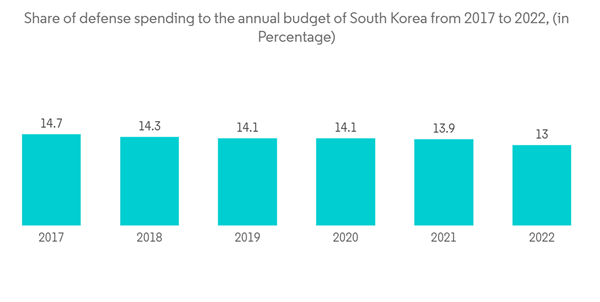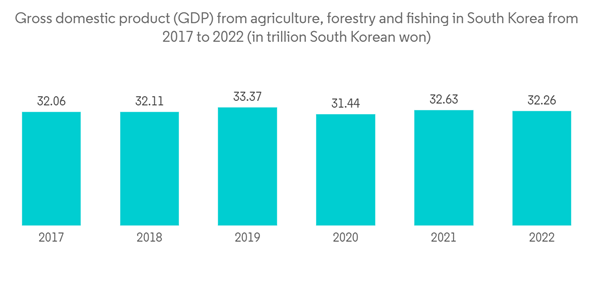Key Highlights
- Aerial photography and mapping services are widely used in urban planning, real estate, agriculture, and infrastructure development sectors. High-resolution aerial imagery provides valuable data for mapping, 3D modeling, and visualizations, which are essential for decision-making and project planning. South Korea is known for its technological advancements, and the imagery service sector is no exception. The country has witnessed the development of high-resolution satellite imagery, unmanned aerial vehicles (UAVs) equipped with advanced cameras, and LiDAR technology, enabling more accurate and detailed mapping and surveying.
- For instance, in December 2022, South Korea released a photo of Pyongyang taken from one of its own satellites after North Korea published imagery of Seoul using what it claimed was a military spy satellite. The released high resolution photo was taken from the lnd satellite No. 1, shows Kim Il-sung Square and its surrounding facilities, including a history museum, an art museum and a department store.
- Another major driver which is boosting the market of satellite imagery service in South Korea is the development of smart city in the country. Imagery services are crucial for gathering and analyzing data, which is essential for smart city development. South Korea has extensively used satellite imagery, aerial photography, and other forms of remote sensing to collect detailed information about urban areas. This data is then integrated with other data sources and processed using artificial intelligence and data analytics techniques to extract valuable insights.
- Furthermore, South Korea has leveraged imagery services for environmental monitoring and management. By analyzing satellite imagery and sensor data, they can monitor air quality, detect changes in vegetation, and manage natural resources more effectively. This enables them to address environmental concerns promptly and develop sustainable practices.
- Moreover, the COVID-19 pandamic impacted the South Korea satellite imagery services market. During the pandamic the government imposed several restriction to control the spread of corona virus. This resulted in the slowdown of field surveys and data collection activities, impacting the availability of ground data for calibration and validation purposes.
South Korea Satellite Imagery Services Market Trends
Growing Use of Satellite Imagery Services in Military and Defense Sector
- Satellite imagery services play a crucial role in the military and defense operations of South Korea. As it provides valuable intelligence to South Korean military intelligence agencies. It allows them to monitor and analyze activities in neighboring countries, especially North Korea. Satellite imagery can help identify military installations, detect missile launches, track troop movements, and assess infrastructure changes.
- Satellites equipped with high-resolution imaging sensors can capture real-time imagery, enabling the South Korean military to monitor areas of interest, including sensitive border regions and disputed territories. This information helps maintain situational awareness, identify potential threats, and plan military operations.
- For instance, in 2022, ST. LOUIS, a South Korean company specializing in satellite imagery analysis developed new techniques to identify missiles, launchers, and supporting infrastructure in North Korea, as North Korean missiles posed a significant threat to neighboring countries, including South Korea, as they carried nuclear and biochemical weapons.
- Looking at the growing technology in defence. the South Korean Ministry of National Defense (MND) announced a mid-term defence budget in December 2022 for the next five year. As per the announcement the government will spend around USD 268.8 billion and every year the budget will increase by 6.8%. This investment will change the shape of South korean defence sector and boost the adoption of new imagery satellite with high resolution images.
- On the other hand, South Korea's geographical location and its maritime disputes with neighboring countries necessitate a strong focus on maritime security. Satellite imagery helps monitor maritime activities, including ship movements, illegal fishing, and potential threats to territorial waters. It assists in enhancing maritime domain awareness and supporting the South Korean navy's surveillance and response capabilities.
Growing Requirement of Satellite Imagery Services in Agricultural Sector
- Satellite imagery allows farmers and agricultural experts to monitor crop growth, health, and performance over time. Analyzing the images, they can identify issues such as nutrient deficiencies, diseases, and pest infestations. This information helps farmers take timely actions, adjust irrigation and fertilization strategies, and make informed decisions to maximize crop yield and quality.
- Moreover, South Korean farmers are adopting precision agriculture techniques that involve the use of satellite imagery, GPS technology, and other data analytics tools. The imagery helps them create detailed field maps, enabling precise application of fertilizers, pesticides, and water. This targeted approach reduces waste, improves resource efficiency, and minimizes environmental impact. For instance, in March 2023, Corteva Agriscience announced the commercial launch of Adavel active, with recent product registrations in three countries, including South Korea.
- Also, the South Korean government is continiously increasing its investment to increase its agricultural sector in the country. In order to this in October 2022, the Korean government announced that it will nurture 30,000 young farmers by 2027. Moreover, to increase the technological advancement in agriculture the South Korean government is also providing a monthly subsidy of 1.1 million won for three years to 4,000 young farmers.
- Furthermore, Satellites equipped with various sensors can capture high-resolution images of agricultural fields from space. These images provide valuable insights into the health and condition of crops. By analyzing the satellite data, farmers can identify potential issues like pest infestations, nutrient deficiencies, or diseases affecting their crops. This early detection allows them to take timely and targeted actions to protect their crops from damage and improve yields. Also, it allows farmers to monitor the growth and development of their crops over time. By comparing current images with historical data, they can track the progress of their crops, evaluate the effectiveness of their farming practices, and make informed decisions for the future.
South Korea Satellite Imagery Services Industry Overview
The South Korea satellite imagery services market is moderately consolidated, with the presence of major players like Dtonic Corporation, Bentley Systems, Inc., Dabeeo Inc., General Electric (GE), ESRI Inc., Soletop InSpace Co., Ltd., GBS Korea, Maxar Technologies, and L3Harris Corporation Inc. Players in the market are adopting strategies such as partnerships, innovations, mergers, and acquisitions to enhance their product offerings and gain sustainable competitive advantage.In May 2023, South Korea announced the launch of commercial-grade satellites. South Korea is pushing to place its first military spy satellite into orbit through this launch. Through this launch, South Korea aims to verify radar imaging technology and observe cosmic radiation in a near-Earth orbit.
Additional Benefits:
- The market estimate (ME) sheet in Excel format
- 3 months of analyst support
This product will be delivered within 2 business days.
Table of Contents
Methodology

LOADING...










